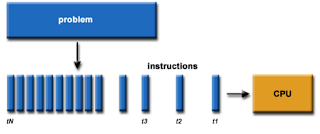What is Parallel computing?
Parallel computing is a type of computation in which many calculations or the execution of processes are carried out simultaneously.
In simple terms we will provide an example:
Suppose you and your 3 other friends are asked to do an assignment, in the assignment have 4 question, each of yours team member will answer 1 of the question simultaneously, I will call it as parallel processing/computing!
In the simplest sense, parallel computing is the simultaneous use of multiple compute resources to solve a computational problem:
It usually gets more
Parallel Computing vs Concurrent Computing
Concurrency is when two or more tasks can start, run, and complete in overlapping time periods. It doesn't necessarily mean they'll ever both be running at the same instant. Eg. multitasking on a single-core machine.
Concurrent execution is possible on single processor
Parallelism is when tasks literally run at the same time, eg. on a multicore processor.
Parallel execution is not possible on single processor but on multiple processors.
Parallel computing is a type of computation in which many calculations or the execution of processes are carried out simultaneously.
In simple terms we will provide an example:
Suppose you and your 3 other friends are asked to do an assignment, in the assignment have 4 question, each of yours team member will answer 1 of the question simultaneously, I will call it as parallel processing/computing!
In the simplest sense, parallel computing is the simultaneous use of multiple compute resources to solve a computational problem:
- A problem is broken into discrete parts that can be solved concurrently
- Each part is further broken down to a series of instructions
- Instructions from each part execute simultaneously on different processors
- An overall control/coordination mechanism is employed

It usually gets more
- Computational power
- fault tolerance
- Larger amount of memory
- Speed up factor
Parallel Computing vs Concurrent Computing
Concurrency is when two or more tasks can start, run, and complete in overlapping time periods. It doesn't necessarily mean they'll ever both be running at the same instant. Eg. multitasking on a single-core machine.
Concurrent execution is possible on single processor
Parallelism is when tasks literally run at the same time, eg. on a multicore processor.
Parallel execution is not possible on single processor but on multiple processors.

Are these posts going to be part of assignments or are you practising over here ?
ReplyDeleteThe writing requires improvement kano but you can improve over the time.
Have better choice of words. :)
Part of the assignment bro...
DeleteOk..bro.i will improve
Good one :)
ReplyDeleteThank you..
DeleteI felt interesting while reading this, good explanation of parallel and concurrent.
ReplyDelete